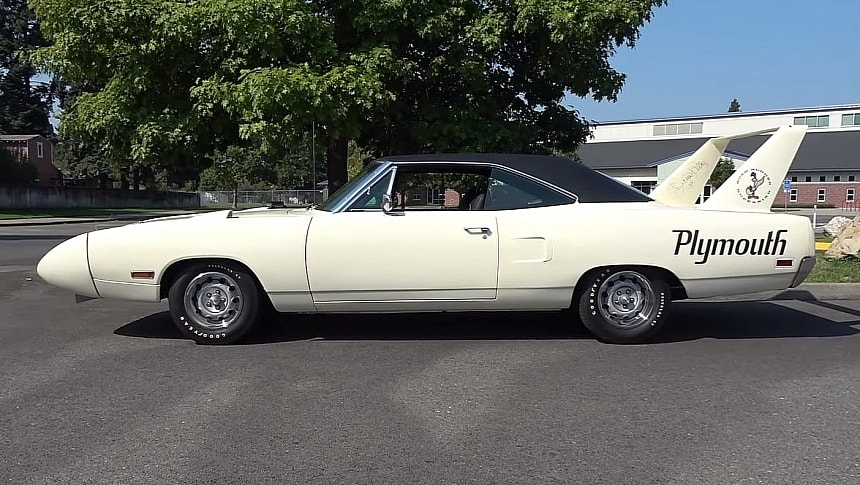The golden muscle car era was packed with fantastic high-performance rigs, but none were as outlandish as Chrysler's "winged warriors." I'm obviously talking about the Dodge Charger Daytona and the Plymouth Superbird.
The Daytona arrived in 1969. Having failed to defeat Ford on NASCAR tracks with the Charger 500, Dodge slapped a nose cone and a massive wing on the latter to create the Daytona. The company sold 503 road-legal units for homologation and wrote history on the oval circuit.
But Plymouth also wanted a piece of the high-winged pie and introduced its own version of the Daytona in 1970. It was based on the Road Runner and largely similar to its Dodge counterpart. In addition to a vinyl top and the fender-top scoops, the Superbird also became available with the 440-cubic-inch (7.2-liter) Six-Barrel. The mill slotted between the base 440 four-barrel and the range-topping 426-cubic-inch (7.0-liter) HEMI.
Plymouth also had to build more units than Dodge for the general public. That's because NASCAR raised the production requirement from 500 examples to one for every two manufacturer's dealers in the United States in 1970. Plymouth had 3,840 dealerships, so it had to produce at least 1,920 units to homologate the Superbird.
The actual number of beefed-up Road Runners built remains unknown, but Mopar experts agree on a production run of 1,935 cars for the US market, plus at least 34 vehicles shipped to Canada.
While Dodge sold its Charger Daytonas rather rapidly, Plymouth struggled to deliver nearly 2,000 Superbirds. The story goes that some unsold units were returned to Road Runner specs, while some Superbirds sat on dealer lots until as late as 1972.
There's no info on whether this Alpine White example is one of those cars, but the Galen Govier report it comes with says it's the last vehicle on the list of 1,920 Superbirds built for NASCAR homologation.
Documented by classic car enthusiast Lou Costabile, this "winged warrior" has been with the same owner for over two decades. He bought it at auction in the early 2000s with a poorly advertised "last Superbird produced" status. It's unclear if this makes it particularly more valuable, but I guess it's a nice feat to have, especially with paperwork from Mopar expert Galen V. Govier.
But that's not the only thing this Superbird can brag about. It's also a nicely restored example that looks perfect from every angle and carries Richard Petty's signature on the rear wing. It's also an authentic V-code rig, meaning it has a 440-cubic-inch Six-Barrel under the hood.
This makes it one of 716 Six-Barrel units made and one of 408 examples fitted with the three-speed automatic transmission. Moreover, it's one of only a few Superbirds being driven regularly. "Cars are meant to be driven," says the owner, who doesn't want to hear about turning this Plymouth into a museum piece. Well, that's something we should definitely see more often.
But Plymouth also wanted a piece of the high-winged pie and introduced its own version of the Daytona in 1970. It was based on the Road Runner and largely similar to its Dodge counterpart. In addition to a vinyl top and the fender-top scoops, the Superbird also became available with the 440-cubic-inch (7.2-liter) Six-Barrel. The mill slotted between the base 440 four-barrel and the range-topping 426-cubic-inch (7.0-liter) HEMI.
Plymouth also had to build more units than Dodge for the general public. That's because NASCAR raised the production requirement from 500 examples to one for every two manufacturer's dealers in the United States in 1970. Plymouth had 3,840 dealerships, so it had to produce at least 1,920 units to homologate the Superbird.
The actual number of beefed-up Road Runners built remains unknown, but Mopar experts agree on a production run of 1,935 cars for the US market, plus at least 34 vehicles shipped to Canada.
While Dodge sold its Charger Daytonas rather rapidly, Plymouth struggled to deliver nearly 2,000 Superbirds. The story goes that some unsold units were returned to Road Runner specs, while some Superbirds sat on dealer lots until as late as 1972.
There's no info on whether this Alpine White example is one of those cars, but the Galen Govier report it comes with says it's the last vehicle on the list of 1,920 Superbirds built for NASCAR homologation.
Documented by classic car enthusiast Lou Costabile, this "winged warrior" has been with the same owner for over two decades. He bought it at auction in the early 2000s with a poorly advertised "last Superbird produced" status. It's unclear if this makes it particularly more valuable, but I guess it's a nice feat to have, especially with paperwork from Mopar expert Galen V. Govier.
But that's not the only thing this Superbird can brag about. It's also a nicely restored example that looks perfect from every angle and carries Richard Petty's signature on the rear wing. It's also an authentic V-code rig, meaning it has a 440-cubic-inch Six-Barrel under the hood.
This makes it one of 716 Six-Barrel units made and one of 408 examples fitted with the three-speed automatic transmission. Moreover, it's one of only a few Superbirds being driven regularly. "Cars are meant to be driven," says the owner, who doesn't want to hear about turning this Plymouth into a museum piece. Well, that's something we should definitely see more often.












